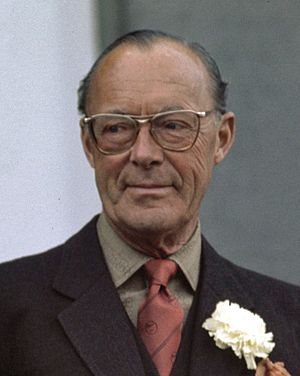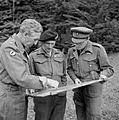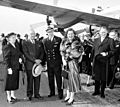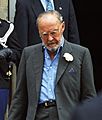Prince Bernhard of the Netherlands facts for kids
Quick facts for kids Prince Bernhard |
|||||
|---|---|---|---|---|---|

Prince Bernhard wearing his trademark carnation, 1976
|
|||||
| Prince consort of the Netherlands | |||||
| Tenure | 6 September 1948 – 30 April 1980 | ||||
| Born | 29 June 1911 Jena, Saxe-Weimar-Eisenach, Germany |
||||
| Died | 1 December 2004 (aged 93) University Medical Center Utrecht, Utrecht, Netherlands |
||||
| Burial | 11 December 2004 Nieuwe Kerk, Delft, Netherlands |
||||
| Spouse |
|
||||
| Issue among others… |
|
||||
|
|||||
| House | Lippe | ||||
| Father | Prince Bernhard of Lippe-Biesterfeld | ||||
| Mother | Armgard von Cramm | ||||
| Religion |
|
||||
| Occupation | Military officer, aviator, conservationist, nonprofit director | ||||
| Signature |  |
||||
Prince Bernhard of Lippe-Biesterfeld (born 29 June 1911 – died 1 December 2004) was a Dutch prince. He was the husband of Queen Juliana of the Netherlands. Together, they had four daughters. One of their daughters was Princess Beatrix, who later became Queen of the Netherlands.
Bernhard was born into the princely House of Lippe in Germany. He was a nephew of Leopold IV, the last ruler of the Principality of Lippe. In 1916, his uncle gave him the title of Prince. He studied law and worked in Paris for a company called IG Farben. In 1937, he married Princess Juliana of the Netherlands. He was then given the title Prince of the Netherlands. When his wife became Queen in 1948, he became the Prince Consort of the Netherlands.
Even though he faced some challenges in his public life, many Dutch people liked Prince Bernhard. They admired his actions during World War II. He was a combat pilot and helped Queen Wilhelmina. He also worked hard during the country's rebuilding after the war.
Contents
Prince Bernhard's Role in World War II
During World War II, Prince Bernhard was involved in planning for the Allies in London. He was a Wing Commander in the RAF. He flew both fighter and bomber planes in battles.
He also became a Dutch general and the Supreme Commander of the Dutch Armed Forces. He helped negotiate the surrender of the German Army in the Netherlands. For his bravery and leadership during the war, he received the Military William Order. This is the Netherlands' oldest and highest honor. After the war, Queen Elizabeth II of the United Kingdom made him an Honorary Air Marshal of the Royal Air Force.
Post-War Activities and Contributions
After the war, Prince Bernhard continued to be active in many important areas. He was known for his work in conservation and international cooperation.
Protecting Nature: World Wildlife Fund
Prince Bernhard helped start the World Wildlife Fund (WWF). This organization is now known as the World Wide Fund for Nature. He became its first president in 1961. In 1970, he created a special fund for the WWF called "The 1001: A Nature Trust." This fund helped support the WWF's work to protect animals and their habitats around the world.
International Discussions: Bilderberg Group
In 1954, Prince Bernhard also helped create the Bilderberg Group. This is an international group that meets every year. They discuss important topics like how countries and businesses work together globally. They also talk about issues affecting Europe and North America.
Later Challenges
In 1976, Prince Bernhard was involved in a situation known as the Lockheed Bribery Scandal. Because of this, he had to step down from his roles with both the World Wildlife Fund and the Bilderberg Group.
Family Life
Prince Bernhard and Queen Juliana had four daughters:
- Princess Beatrix
- Princess Irene, Duchess of Parma
- Princess Margriet
- Princess Christina
Princess Beatrix later became Queen of the Netherlands in 1980. She ruled until 2013.
Later Years and Legacy
Prince Bernhard passed away on 1 December 2004, at the age of 93. His funeral was held in Delft on 11 December 2004. He is remembered for his service during World War II and his efforts in conservation and international relations.
Images for kids
-
Princess Juliana and Prince Bernhard with their oldest daughters Princess Beatrix and Princess Irene in Ottawa on 4 May 1942.
-
General Brian Horrocks, Field Marshal Bernard Montgomery and Prince Bernhard before Operation Market Garden on 8 September 1944.
-
Queen Juliana and Prince Bernhard with President of the United States Harry S. Truman and First Lady Bess Truman at Washington National Airport on 2 April 1952.
-
Prince Bernhard arriving at Amsterdam Airport Schiphol on 4 November 1959.
-
Prince Bernhard wearing his trademark carnation in Amsterdam on 6 July 1999.
-
The state funeral of Prince Bernhard in Delft on 11 December 2004.
See also
 In Spanish: Bernardo de Lippe-Biesterfeld para niños
In Spanish: Bernardo de Lippe-Biesterfeld para niños








